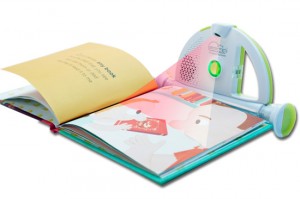When we last left Amir and Roei, they were searching for an engineer-designer duo to help realize their concept for the Sparkup.
The engineer needed to be proficient in computer recognition technology; someone who could find creative solutions to integrate cost-efficient components that would keep prices low for the consumer. Amir and Roei had the good fortune of meeting Denis Simakov, who ended up developing Sparkup’s core technology and currently serves as the company’s CTO. He had trained and worked as a software developer and engineer, having developed some of the algorithms that run in the Samsung Galaxy camera mode.
Like the Scarecrow from the Wizard of Oz, Sparkup needed a “brain” that could recognizes a book’s front cover and individual pages. Denis initially wrote algorithms (a series of equations, essentially steps, that would guide Sparkup’s “brain”) to operate on an ARM 9 MCU 190 mhz processor (to put that into perspective, the iPhone 5 runs on a 1.3 ghz CPU). The problem was that it took the device nearly 50 seconds to recognize a single page with the 190 mhz system and the current software. By further optimizing the software, Denis managed to give Sparkup a “brain” that operated on just a 64 mhz MCU, but could recognize a page in less than half a second—quite a feat!
Another challenge involved Sparkup’s “eye” – the camera—which would transmit information to its “brain”. Algorithms that worked very well on a standard webcam were unsuccessful in the first Sparkup prototype, because it could barely “see” a page. The developers came up with a custom-built yet cost-effective camera that greatly improved Sparkup’s “vision”.
It took nearly three years to develop and refine that proprietary technology, which is currently the most cost-effective visual recognition system available in the world.
Now the question remained: just how would they fit these components into a compact device with a seamless user-interface? Amir and Roei are both Apple and iPhone design fanatics, so they set the bar very high.
They engaged Ezri Tarazi to, literally, put the pieces together. To put it simply, Ezri is a design master. Ezri oversaw the industrial design division at Keter Plastics, the largest manufacturer of resin-based consumer products in Israel, and served as head of the Department of Industrial Design at the Bezalel Academy, where he later founded and chaired the MA department in the same field. Check out some of his innovative design projects from the Tarazi Design Studio.
Ezri decided to begin with a simple circle, to which he added the additional components: the buttons, camera, chip, clip and speakers. When asked what inspired this design, Ezri grinned sheepishly and answered, “Well…a pita. I needed a basic form that would hold these different parts.”
The hollowed-out segment opposite the speaker serves as a handle, which allows for easy handling. Various textures cover the different surfaces of the Sparkup—a screen covering the speaker, grooves on the reverse, a smooth face, a textured transparent clip—which create a multi-faceted tactile experience.
Creating a seamless user-interface was crucial for everyone. “Form follows a simple story”, says Ezri. The Sparkup’s main button rests at its center, its heart. Press the button to bring Sparkup to life. It’s that simple. After all, Ezri pointed out, “the Sparkup can’t live without a book.”
And so Sparkup was given form and life. In less than a month, Sparkup will launch in the US on July 20th on QVC and qvc.com. We are partnering with leading retailers and publishers as we expand the Sparkup universe; we’ll keep you updated every step of the way.
But remember: it’s the books that make Sparkup come alive with magic!


Leave a Reply